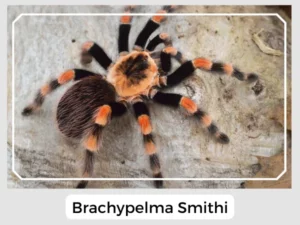Meet the Brachypelma smithi. This tarantula loves to call Mexico its home. It has a close look-alike named Brachypelma hamorii, and both are known as the Mexican redknee tarantula. Some even thought they were the same!
Following the mating and laying of the fertilized eggs, the female will wrap them in webbing. She then carries the egg sac around in her mouthparts until they are ready to hatch.
After 1-3 months, the eggs hatch, though the spiderlings, or slings, will remain inside the egg sac for 3 weeks more. Once this period has passed, they stay in the burrow for another 2 weeks before dispersing, becoming independent by this stage.
Males sexually mature at 4 years of age, while females do so later at 6-7 years.
Like other tarantulas, these spiders do not construct elaborate webbing for capturing prey. However, they will lay down a carpet of silk threads in front of their burrow to help them detect any intruders.
Yes, Brachypelma smithi tarantulas have venom. They use it to catch the bugs they love to eat. For humans, this venom isn’t typically a big concern.
They sure can! These tarantulas are mostly calm, but if they feel cornered, they might bite. It’s always good to give them space and admire from afar.
The Brachypelma smithi tarantula is integral to its ecosystem, acting as both predator and prey. Its predatory habits help control populations of insects and other small animals, contributing to the ecological balance.
Natural Predators: While formidable, the Mexican redknee tarantula is preyed upon by coatis and specialized wasps, which helps regulate their numbers in the wild.
Prey-Predator Dynamics: By feeding on various small animals, these tarantulas aid in keeping the food web in check, preventing the overpopulation of certain species.
Relationship with Humans: Humans have a complex relationship with Brachypelma smithi. While they pose little danger to us, their popularity in the pet trade has led to conservation concerns, highlighting the need for responsible wildlife management.
| Other names | Mexican redknee tarantula |
| Lifespan | Males: 10 years, Females: 25-30 years |
| Distribution | Mexico, specifically the state of Guerrero |
| Habitat | Tropical deciduous forests |
| Predators | White-nosed coati, pepsis wasps |
| Diet | Frogs, large insects, mice |

In conclusion, Brachypelma smithi tarantulas are remarkable creatures that play a crucial role in their natural habitat.
Meet the Brachypelma smithi. This tarantula loves to call Mexico its home. It has a close look-alike named Brachypelma hamorii, and both are known as the Mexican redknee tarantula. Some even thought they were the same!
Following the mating and laying of the fertilized eggs, the female will wrap them in webbing. She then carries the egg sac around in her mouthparts until they are ready to hatch.
After 1-3 months, the eggs hatch, though the spiderlings, or slings, will remain inside the egg sac for 3 weeks more. Once this period has passed, they stay in the burrow for another 2 weeks before dispersing, becoming independent by this stage.
Males sexually mature at 4 years of age, while females do so later at 6-7 years.
Like other tarantulas, these spiders do not construct elaborate webbing for capturing prey. However, they will lay down a carpet of silk threads in front of their burrow to help them detect any intruders.
Yes, Brachypelma smithi tarantulas have venom. They use it to catch the bugs they love to eat. For humans, this venom isn’t typically a big concern.
They sure can! These tarantulas are mostly calm, but if they feel cornered, they might bite. It’s always good to give them space and admire from afar.
The Brachypelma smithi tarantula is integral to its ecosystem, acting as both predator and prey. Its predatory habits help control populations of insects and other small animals, contributing to the ecological balance.
Natural Predators: While formidable, the Mexican redknee tarantula is preyed upon by coatis and specialized wasps, which helps regulate their numbers in the wild.
Prey-Predator Dynamics: By feeding on various small animals, these tarantulas aid in keeping the food web in check, preventing the overpopulation of certain species.
Relationship with Humans: Humans have a complex relationship with Brachypelma smithi. While they pose little danger to us, their popularity in the pet trade has led to conservation concerns, highlighting the need for responsible wildlife management.
| Other names | Mexican redknee tarantula |
| Lifespan | Males: 10 years, Females: 25-30 years |
| Distribution | Mexico, specifically the state of Guerrero |
| Habitat | Tropical deciduous forests |
| Predators | White-nosed coati, pepsis wasps |
| Diet | Frogs, large insects, mice |

In conclusion, Brachypelma smithi tarantulas are remarkable creatures that play a crucial role in their natural habitat.